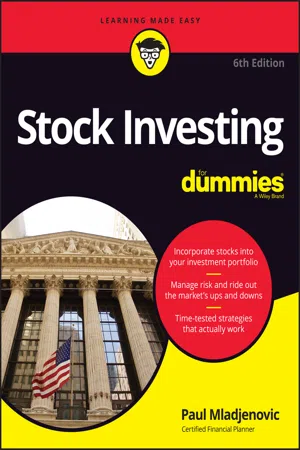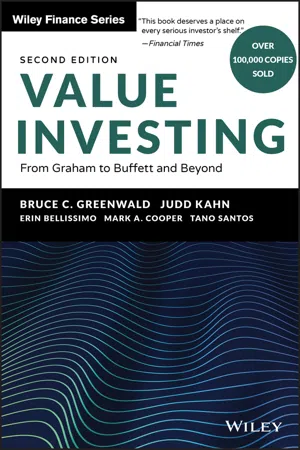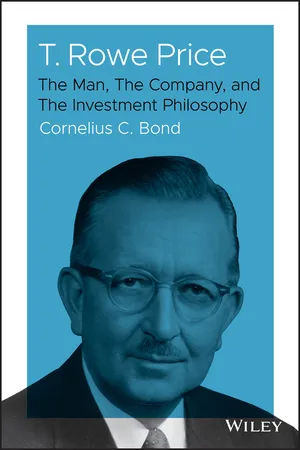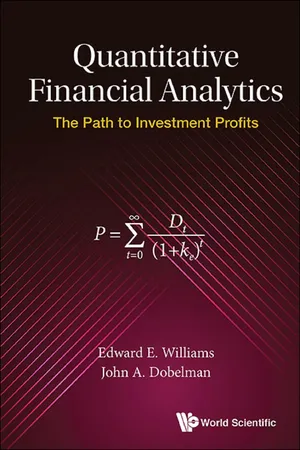Business
Growth Stocks
Growth stocks are shares in companies that are expected to grow at an above-average rate compared to other firms in the market. These companies typically reinvest their earnings into expansion and innovation rather than paying dividends to shareholders. Investors are attracted to growth stocks for their potential for high returns, but they also carry a higher level of risk due to their reliance on future growth.
Written by Perlego with AI-assistance
Related key terms
Related key terms
1 of 4
Related key terms
1 of 3
6 Key excerpts on "Growth Stocks"
- No longer available |Learn more
- Paul Mladjenovic(Author)
- 2020(Publication Date)
- For Dummies(Publisher)
Usually, you compare the growth of a company with growth from other companies in the same industry or with the stock market in general. In practical terms, when you measure the growth of a stock against the stock market, you’re actually comparing it against a generally accepted benchmark, such as the Dow Jones Industrial Average (DJIA) or the Standard & Poor’s 500 (S&P 500). For more on stock indexes, see Chapter 5. If a company’s earnings grow 15 percent per year over three years or more, and the industry’s average growth rate over the same time frame is 10 percent, then the stock qualifies as a growth stock. You can easily calculate the earnings growth rate by comparing a company’s earnings in the current year to the preceding year and computing the difference as a percentage. For example, if a company’s earnings (on a per-share basis) were $1 last year and $1.10 this year, then earnings grew by 10 percent. Many analysts also look at a current quarter and compare the earnings to the same quarter from the preceding year to see whether earnings are growing. A growth stock is called that not only because the company is growing but also because the company is performing well with some consistency. Having a single year where your earnings do well versus the S&P 500’s average doesn’t cut it. Growth must be consistently accomplished. Considering a company with a strong niche Companies that have established a strong niche are consistently profitable. Look for a company with one or more of the following characteristics: A strong brand: Companies such as Coca-Cola and Microsoft come to mind. Yes, other companies out there can make soda or software, but a business needs a lot more than a similar product to topple companies that have established an almost irrevocable identity with the public. High barriers to entry: United Parcel Service and Federal Express have set up tremendous distribution and delivery networks that competitors can’t easily duplicate - eBook - ePub
Value Investing
From Graham to Buffett and Beyond
- Bruce C. Greenwald, Judd Kahn, Erin Bellissimo, Mark A. Cooper, Tano Santos(Authors)
- 2020(Publication Date)
- Wiley(Publisher)
Despite these difficulties, Warren Buffett, Charlie Munger, and several other modern value-oriented investors have earned consistently above market returns by investing in growing franchise businesses. They have demonstrated that a disciplined value approach to investing in growth opportunities can be successful. A traditional value investor will sell when a company's market price reaches or exceeds its value. If the value is static, the investor sells when the price has recovered from what is often a temporary sell-off or setback. This recovery approach defines a fixed horizon for earning a decent return. But if the value of the company increases continuously, it may be many years before a company's value and market price converge. A longer holding period means lower trading frequencies, lower transaction costs, and deferral of capital gains taxes for many years. As a consequence, while investing intelligently in Growth Stocks is difficult, it is an essential and worthwhile extension of the traditional Graham and Dodd approach to investing.An investment based on a firm's prospects for growth must satisfy two requirements. First, the growth must create value, which is no sure thing. For most companies—more precisely for the shareholders of most companies—growth is at best a break-even proposition. As we noted briefly in Chapter 4 , this sobering news applies equally to high-tech firms that expand by selling more superbly engineered tools or aesthetically elegant gadgets, to online retailers who multiply their offerings, and to restaurant franchisers that expand by opening more outlets. Growth creates value only when the investments required to support the growth earn more than the cost of capital. In the distinction we made in Chapter 3 , in Figure 3.2 , it is only Case C, where earnings power value significantly exceeds assets values, that growth will produce net distributable cash after investment to existing investors.Second, not all growth—even growth that is worth something—can be appraised with enough precision to permit an accurate valuation. Because value investors demand a margin of safety, they will buy growth only at a substantial discount from its estimated value, a discount large enough to make up for the greater uncertainty in valuation. The ideal price for growth is zero: pay in full for the current assets or earnings power and get the growth for free.Despite these warnings, there are circumstances under which even disciplined value investors may pay something for growth and be rewarded provided they keep these two requirements squarely in view: (1) that the growth will in fact create value; (2) that there is a measurable margin of safety included in the price paid for it. Though the first rule is uncomplicated, it is not well understood by most investors. The second calls for a major readjustment in the Graham and Dodd approach to valuation. We will discuss the two requirements one at a time. In this chapter, we will identify the circumstances under which growth genuinely creates value, as distinguished from those in which either growth contributes nothing and can therefore be ignored in the investment decision or those in which growth actually destroys value and investment should be avoided entirely. In Chapter 8 - eBook - ePub
T. Rowe Price
The Man, The Company, and The Investment Philosophy
- Cornelius C. Bond(Author)
- 2019(Publication Date)
- Wiley(Publisher)
But what are the great growth companies of today? For most investors who are working hard in their jobs, or who just don't have the time or inclination to do all the required homework, the best answer is to stick to the above mutual funds and let the experts discover these companies. For those with the time and inclination to begin to manage a portion of their own portfolios, after investing perhaps 60 percent of their assets in mutual funds, and who have absorbed and believe in the lessons of this book, we would suggest that they look carefully at the portfolios of the mutual funds that have won the Morningstar annual awards. An investor might get an idea of which companies these managers believe to be the best Growth Stocks by examining their top ten holdings. Because these positions are subject to change from actions of the portfolio manager, it would be wise to check in each quarter to see if all of these companies are still on the list.In managing a portfolio, it is well to remember Mr. Price's advice to gradually take profits, as a company becomes a large percent of a portfolio, and certainly when it becomes excessively overvalued. His goal was to recover his original capital by selling a portion of such holdings as they rise and depositing the funds in a quality income fund mentioned above. He would retain the remaining shares as long as the company remained a growth stock. Bob would politely disagree. He does not sell because of temporary overvaluation. He points out that the best companies do grow faster than the pack. By allowing this to occur without any pruning, the best stocks automatically grow relatively larger, creating faster overall growth for the portfolio. Moreover, there are no capital gains to pay. Having personally experienced, as president of the Growth Stock Fund, the long slow recovery of Growth Stocks from their overvaluation in the early 1970s, I am probably more in Mr. Price's camp. We leave the reader to make the choice between the two strategies.To build a retirement account over several decades, an interested investor with extra time might want to become more venturesome. He or she might begin by adding shares of companies that are familiar through a job or from a consumer standpoint, again using the basic concepts for picking growth companies discussed in Chapter 9 . Financial data can be obtained online or through a subscription to a service such as Value Line. Managements often speak at investment forums around the country or at annual meetings, where they can be individually questioned. Fortune - eBook - ePub
Quantitative Financial Analytics
The Path to Investment Profits
- Edward E Williams, John A Dobelman;;;(Authors)
- 2017(Publication Date)
- WSPC(Publisher)
growth stock. These shares outperform the economy and most other equities in their respective industries. Growth companies typically pay negligible dividends because they can do better for their shareholders by retaining earnings and reinvesting in plant and equipment. They are aggressive in their search for new, profitable opportunities, and they typically spend a great deal on research and development. Many Growth Stocks are also blue chips, with such stock market stars as Apple and Microsoft as prime examples.When a stock shows a sustained earnings growth pattern over a long period of time, the dividend paying potential of the security increases. For this reason, shareholders are willing to pay large P/E multiples for Growth Stocks. Indeed, some of the leaders among the growth equities have sold at 50 and even 100 times current earnings. Although most investors who pay these prices for growth securities believe that they are purchasing equities for capital gains, they are in fact buying a growing expected future dividend stream. Price appreciation occurs, of course, and this is due to the improved dividend paying abilities of the firm. Even though the firm may pay no dividend for years, as it retains earnings and grows, the fact that it could pay a larger dividend (and eventually will when its growth rate declines) produces the share price appreciation. Equation (7.8) is a very appropriate valuation model for growth shares. Reiterating,In general, the first term on the right-hand side of the equation will be small, because dividend payments in the near future will, in all likelihood, be negligible or even non-existent. The return to investors is produced by the price appreciation from P0 to Pn ; and, as we indicated above, Pn is determined by the dividend stream remaining beyond period n. Reiterating Equation (7.9):The relationship between share price movements and the timing of future dividend payments can be seen with an example. Suppose the Alpha, Beta, and Gamma Corporations are expected to maintain the following pattern of dividend payments:Shareholders desire a 10 percent return and will pay prices for each firm’s shares that will produce a 10 percent yield. Notice initially that each company will pay $1 per year forever beginning in year 4. Thus, the price of each share should be ($1.00/0.1) = $10 at the beginning of year 4 and thereafter, with the 10 percent return represented by the $1 dividend in relation to the $10 price. For Alpha, the same analysis applies presently. The current price should be $10 and should remain there for the next three years. Within each year, the price of the stock would tend to rise as the dividend payment date approached. Theoretically, the price would be $10 right after a dividend payment and would rise to $11 just before the next payment. Once the dividend were declared (and shareholders as of a given record date were scheduled to receive their $1 per share), the stock would sell “ex-dividend” and would fall back to $10. For Gamma, the price pattern would be: - eBook - ePub
Invest Like You Give a Damn
Make Money, Change the World, Sleep Well at Night
- Marc de Sousa-Shields(Author)
- 2017(Publication Date)
- New Society Publishers(Publisher)
Preferred stock combines features of debt, in that it pays fixed dividends, and equity and has the potential to appreciate in price. The details of each preferred stock vary.Source: investopedia.comEquity investing refers to the buying, holding, and selling of company stocks. Most stocks are listed on a regulated stock market. Returns from shares come as capital gains (i.e., share prices rise as a company’s overall market value rises) and dividends, cash, or stock that a company determines to distribute to its shareholders (usually quarterly). Common share ownership gives you a vote at company annual meetings, or, as noted in Chapter Three , you can give your vote to a third party, such as a financial adviser or the managers of a fund that you invest in.Equities come in all shapes and sizes. For now, it’s important to know only the basics. There are common shares and preferred shares (explained in box). There are large, mid, and small “cap” stocks. These refer to the total market capitalization of the company (the price per share multiplied by the number of shares available for purchase; this is explained further in the next section). Investors also refer to value or Growth Stocks. Value stocks are judged to be trading at a price-to-earnings ratio below average and are deemed to be undervalued because their prospects for growth are not reflected in the stock valuation. Growth Stocks trade above the average price-to-earnings ratio because they are deemed to have greater prospects for growth. Put another way, their earnings growth is relatively high.The second most common investments are corporate and government bonds . These are debt securities issued by companies or governments and sold to investors. A company’s ability to generate income to repay bonds - eBook - ePub
Dividends Still Don't Lie
The Truth About Investing in Blue Chip Stocks and Winning in the Stock Market
- Kelley Wright(Author)
- 2010(Publication Date)
- Wiley(Publisher)
(T) from late June 2009 reflects the type of higher-yielding stock an income investor would look for. As an aside, it is ironic that the U.S. government spent years tearing the old Ma Bell apart. Today, the old gal is stronger than she ever was. The Growth Investor This sketch covers a wide swath as there are multiple objectives that typically fit into this genre. For tax purposes, investors in a higher income tax bracket may find shares of low-yield/high-Growth Stocks more attractive than shares with higher dividend-yields. With these types of stocks there is the wealth-building component of rising stock prices, but the dividends are not sufficiently high to catapult the investor into a higher tax bracket. Another investor who would be more inclined toward growth would be someone who might not yet have reached the level of affluence but who, nonetheless, is in his or her peak earning years; someone who decides to forgo current income in favor of capital gains, which will build wealth for the retirement years. The Young Investor Last is the younger investor who has yet to reach his peak earning potential, has a long-term investment horizon, and has a higher risk tolerance than does an older investor. This investor may opt for more aggressively growing companies with higher P/E ratios and lower dividend payouts to accumulate capital gains in the early years, and then move toward higher-dividend-yielding stocks in the later years as retirement looms closer. Figure 9.4 for Nike, Inc. (NKE) from mid-August 2009 illustrates a stock that would be attractive to the growth investor. Since declining to the historically repetitive area of undervalue in 2000, NKE has remained in a steady rising trend due to smaller but consistent dividend increases. An excellent opportunity to add to positions occurred between October 2008 and the present. Note that NKE must rise considerably before reaching the overvalue level
Index pages curate the most relevant extracts from our library of academic textbooks. They’ve been created using an in-house natural language model (NLM), each adding context and meaning to key research topics.
Explore more topic indexes
Explore more topic indexes
1 of 6
Explore more topic indexes
1 of 4





